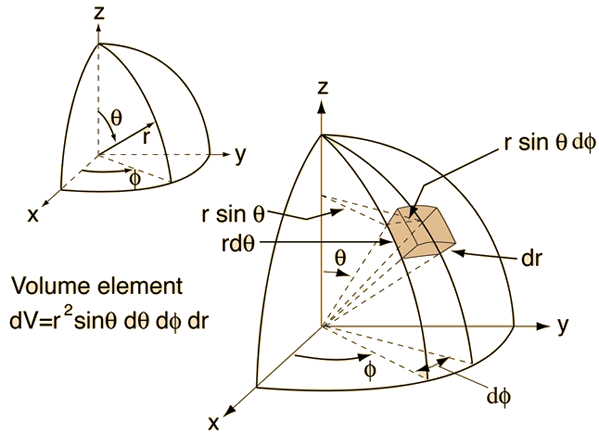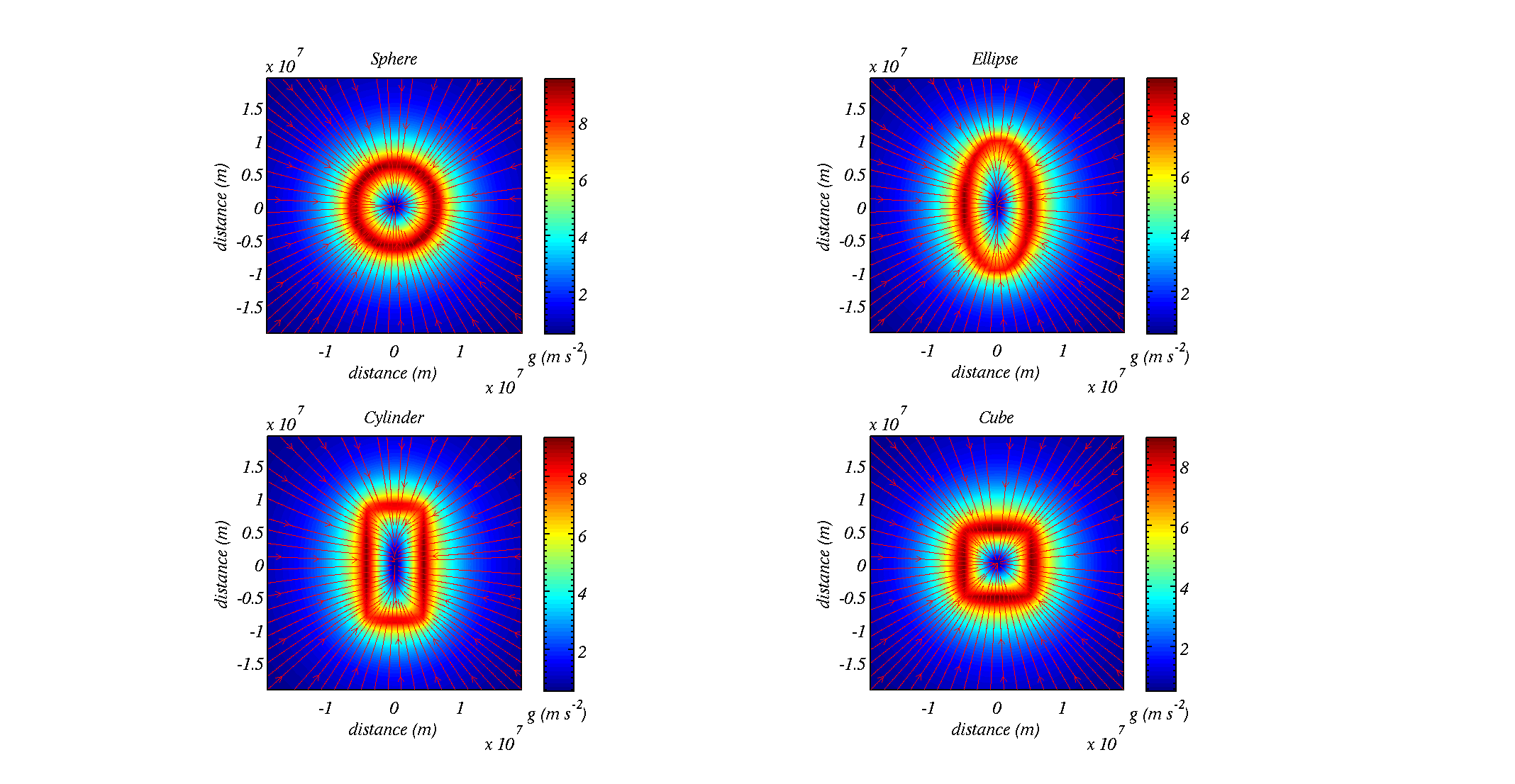Gravitational field strength for a sphere
- Setting up the problem
-
The aim of this worksheet is to set up and solve an integral to calculate the gravitational field strength on the surface of an earth-like planet
Newton's Law of Universal Gravitation describes the force between two point masses, m_1 and m_1 separated by the vector \vec{r}_{1,2}.
\vec{F}=G\frac{m_1 m_2}{r_{1,2}^3} \vec{r}_{1,2}
In order to calculate the gravitational field strength of a planet we can apply this law to infinitesimal mass elements of a sphere. The gravitation field strength is then the sum of all contributions from each mass element. In otherwords we treat each small element of a sphere as point masses and integrate up their contribution to the gravitational force.
Some further definitions... - Spherical coordinate system
-
We use spherical coordinates to solve this problem because the problem's boundary is a sphere. This makes it easier to define the limits in any integrals we set up.
We also need to define distances between objects that aren't necessarily at the origin. This is most easily done in Cartesian coordinates (x, y and z); hence, it is useful to know how to convert between spherical and cartesian coordinates.
More info on spherical coordinates... - The volume and mass elements
-
We assume that the density of the sphere is constant and equal to the ratio of the mass of earth to the volume of earth. In this case a mass element is the density, \rho, multiplied by the volume element, dV.
More info on volume element... - Element of force on an mass m_1 at distance R_1 from the centre of sphere
-
This problem can be simplified by recognising that the magnitude of the force on an object only depends on the distance from the centre. We therefore choose the position of the object to lie at distance R_1 along the z-axis.
More on the element of force... - Element of force in z-direction
-
The gravitational field strength due to a sphere acts downwards towards the centre. Thus, because of symmetry we may neglect other forces (they cancel each other exactly). For our mass, m_1 we therefore need to calculate the force in the z-direction. We therefore need to resolve the full force into a component that points only along the z-axis and integrate that up.
More on the element of force in the z-direction... - Integrating the elements up
-
Once we have written down the force elements we just need to integrate them all up. We need to evaluate the following triple integral:
F_z=Gm_1\rho \int _0^{2\pi} \int _0^{R_e} \int _0 ^\pi \frac{r^2\sin\theta\left(R_1-r\cos\theta\right)}{\left(r^2+R_1^2-2R_1r\cos\theta \right)^{3/2}} \,d\theta d\phi dr
The integration...which yields:
F_z=m_1 \times \frac{4}{3}\pi \rho R_e^3 \times \frac{G}{R_1^2}
the factor \frac{4\pi\rho R_e^3}{3} is the mass of the planet, m_e=6.0\times 10^{24} kg. If R_1=R_e (i.e. the mass is on the surface) then \frac{Gm_e}{R_e^2} is the gravitational field strength, usually referred to as g, which agrees well with the measured value.
Substituting R_e=6.4\times 10^4 m; m_e=6.0\times 10^{24} kg and G=6.67\times 10^{-11} m3 kg-1 s-2 yields g=9.8 m s-2.
- MATLAB scripts part 1
-
There is a MATLAB script here that solve this problem approximately:
Download it to MATLAB and take a look at the code, reading the comments as you go through. For more information on running it click on the tab below.MATLAB gravity script... - MATLAB scripts part 2
-
There is another MATLAB script here that is used in conjunction with the first script:
This script moves the point mass around to map out the gravity field due to different shapes.
Download it to MATLAB and take a look at the code, reading the comments as you go through. For more information on running it click on the tab below.MATLAB batch script...

